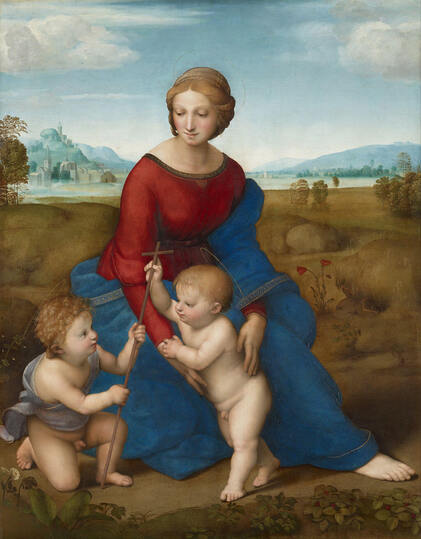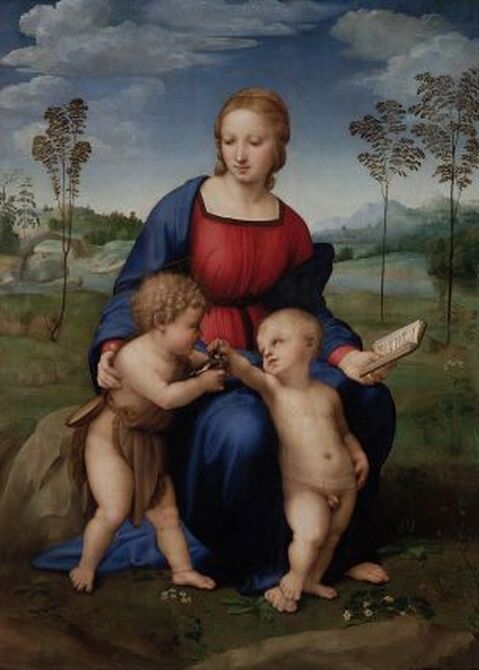|
Where? Gallery 20 of the National Gallery of Art
When? 1510-1511 Commissioned by? Probably Paolo Giovio, though it could also have been Pope Julius II. What do you see? The beautiful Mary sits on a tree trunk with her son Jesus on her right leg, and Saint John sits next to them on the ground. Mary is dressed in a pink and blue dress, Saint John in a fur robe, and Jesus is naked. Mary is holding a prayer book in her left hand. She looks at the cross that Saint John seems to hand to Jesus. Saint John looks at Jesus and Mary, while Jesus looks at Saint John. Their gazes seem somewhat sad as if they are thinking about what is going to happen to Jesus at the end of his earthly life. Notice the index finger of Jesus that is pointing upwards to God while he receives the cross. Saint John holds some flowers, including anemones and white dandelions. The painting is very peaceful with a calm sky, and the trio is surrounded by flowers, including cyclamen (to the left of Saint John), blue violets (in the left foreground), and lady’s bedstraw (the tall plants on the right). The landscape is probably inspired by the Tiber valley near Rome. Backstory: Raphael painted this work while he was in Rome, at the same time that he worked on the famous Raphael Rooms in the Vatican Museums. It is most likely that this painting was commissioned by Paolo Giovio and gifted to the church of the Olivetani in Nocera dei Pagani when he was appointed a bishop there. However, some people also argue that it could have been commissioned by Pope Julius II who Raphael was working for in 1510. The name of the painting, Alba Madonna, is given because the painting was owned by the aristocratic Spanish House of Alba during the 18th century. As Raphael painted many Madonna-themed paintings, this name differentiates it from the others.
Tondos? This painting of Raphael is a so-called tondo. A tondo is used to refer to a circular painting over two feet (60 cm) in diameter. The word ‘tondo’ is derived from the Italian word ‘rotondo’, which means round. A tondo helps the viewer to focus on the center of the painting. The circular shape is also perceived to be an ideal and infinite shape. These are the reasons that the tondo was often used for Madonnas as the focus of those paintings had to be on Mary and Jesus. You can also see in this painting that the composition of Mary, Jesus, and Saint John is quite circular.
The tondo format was mainly popular in the 15th and 16th century and has been used by painters such as Botticelli, Michelangelo, and Raphael. One of the most well-known tondos is the Doni Tondo by Michelangelo in the Uffizi Museum in Florence. Another example is the Madonna of the Magnificat by Botticelli which is also in the Uffizi.
Fun fact: Raphael has created many religious paintings during his career, and especially many Madonnas. However, Raphael did not always live like a religious person. In fact, rumors are that he had many affairs with women while he was in Rome. In 1514 he got engaged to Maria Bibbiena, but he never married her.
Vasari also writes in his book that Raphael died (which may have been on his birthday) after a night of excessive sex. After the wild night he got sick but did not want to tell the doctors the cause of it. As a result, they did not provide him with the right treatment and he died.
Written by Eelco Kappe
References:
0 Comments
Leave a Reply. |
Categories
All
|
- Home
- Blog
-
Museums
- Alte Pinakothek
- Art Institute of Chicago
- Baltimore Museum of Art
- Barber Institute of Fine Arts
- Bargello
- Barnes Foundation
- British Museum
- Church of Sant’Anastasia
- Cleveland Museum of Art
- Courtauld Institute of Art
- Detroit Institute of Arts
- Frans Hals Museum
- Galleria Borghese
- Gallerie dell'Accademia
- Getty Museum
- Guggenheim
- Hermitage Museum
- Kunsthistorisches Museum
- Kunstmuseum Basel
- Legion of Honor Museum
- Louvre
- Mauritshuis
- Metropolitan Museum of Art
- Musee d’Orsay
- Museum of Fine Arts in Boston
- Museum of Modern Art
- National Gallery in London
- National Gallery of Art
- National Museum in Poznań
- Norton Simon Museum
- Ny Carlsberg Glyptotek
- Palace of Versailles
- Palazzo Pitti
- Palazzo Vecchio
- Petit Palais
- Philadelphia Museum of Art
- Prado
- Pushkin Museum
- Ravenna Art Museum
- Rijksmuseum
- San Diego Museum of Art
- Santa Maria delle Grazie
- St. Peter's Basilica
- Städel Museum
- Statens Museum for Kunst
- Tate Britain
- Tate Modern
- Timken Museum of Art
- Uffizi
- Vatican Museums
- Wallace Collection
-
Artists
- Altdorfer
- Anguissola
- Berlin Painter
- Bosch
- Botticelli
- Boucher
- Bronzino
- Bruegel the Elder
- Brunelleschi
- Cabanel
- Caillebotte
- Canova
- Caravaggio
- Carpeaux
- Cezanne
- Cimabue
- David
- Degas
- Delacroix
- De Maria
- Donatello
- El Greco
- Fontana
- Fra Angelico
- Fragonard
- Gauguin
- Gentileschi
- Gericault
- Gonzalez-Torres
- Goya
- Hals
- Hogarth
- Hokusai
- Ingres
- Leonardo da Vinci
- Lippi, Filippo
- Longhi, Barbara
- Lorrain
- Makovsky
- Manet
- Massys
- Matisse
- Merian
- Michelangelo
- Mochi
- Modigliani
- Monet
- Panini
- Parmigianino
- Perugino
- Picasso
- Pisanello
- Raphael
- Rembrandt
- Renoir
- Reynolds
- Rivera
- Rodin
- Rubens
- Scultori
- Seurat
- Steen
- Tintoretto
- Titian
- Toulouse-Lautrec
- Turner
- Uccello
- Van der Weyden
- Van Dyck
- Van Eyck
- Van Gogh
- Van Hemessen
- Vasari
- Velazquez
- Vermeer
- Veronese
- Vigée Le Brun
-
Locations
- Books
- About Us





